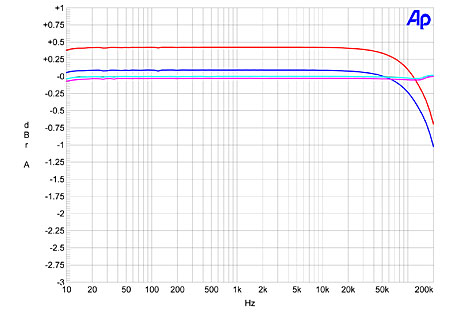| Columns Retired Columns & Blogs |
MBL 6010 D preamplifier Measurements
Sidebar 3: Measurements
I examined the MBL preamplifier's measured behavior primarily using Stereophile's loaner sample of the top-of-the-line Audio Precision SYS2722 system (see the January 2008 "As We See It" and www.ap.com), with my vintage Audio Precision System One Dual Domain also seeing some use.
The MBL's optional phono module offered a high gain of 68.4dB (measured at the Tape Out jacks), which, in conjunction with the module's excellent signal/noise ratio—66.6dB, audioband, unweighted, ref. 500µV at 1kHz—will make it suitable for use with low-output moving-coil cartridges. The maximum line-input gain from the optional balanced input, with the volume control set to "101.1" and measured at the balanced output jacks, was 15.3dB; from the CD input, measured at the unbalanced RCA jacks, the maximum gain was 6dB lower, as anticipated. The input attenuator for each reduced these figures by up to 13dB, the output attenuator by just over 12dB. The unity-gain setting of the volume control for fully balanced operation was "79.1." Both balanced and unbalanced inputs preserved absolute polarity; ie, were non-inverting.
The 6010 D's output impedance was appropriately low for a preamplifier, at 200 ohms balanced and 100 ohms unbalanced. The input impedance depended on which input was selected. The balanced module offered 10.3k ohms across the audioband, the phono module 130 ohms across the band. The input impedance of the line-level inputs, however, depended on which was selected. While Tuner and Tape offered 47k ohms at low and midrange frequencies, dropping slightly but inconsequentially to 41k ohms at the top of the audioband, CD was a very low 3.6k ohms at all frequencies. While this would not have been a problem with Michael Fremer's Musical Fidelity player, which has a source impedance of just 47 ohms, it will result in a rather lean-sounding bass with players having a capacitor-coupled tubed output stage. Such players should be used with one of the MBL preamp's other line-level inputs.
The phono stage offered superbly flat RIAA correction (fig.1), with excellent matching between channels. However, it did appear to offer the IEC modification of the RIAA equalization, with an output 3dB down at 20Hz. Phono-stage overload margins (ref. 500µV at 1kHz) were excellent, at 19dB at midrange and high frequencies, this increasing to 22dB at 20Hz due to the LF rolloff mentioned above.

Fig.1 MBL 6010 D, phono-stage RIAA error, measured at Tape Out jacks (0.5dB/vertical div., right channel dashed).
The line-stage frequency response with the volume control set to its maximum was flat to 200kHz for both balanced and unbalanced operation (fig.2, cyan and magenta traces), with superb channel matching and no change into impedances as low as 600 ohms. But while the response in the audioband remained flat with the volume control set to unity gain (fig.2, blue, red), a slight ultrasonic rolloff can now be seen, along with a channel imbalance of around 0.4dB. Channel separation (not shown) was excellent in the unbalanced operational modes, at >90dB below 20kHz. The balanced module was slightly better below 5kHz, but the crosstalk increased by 8dB at 20kHz.

Fig.2 MBL 6010 D, unbalanced frequency response at 1V into 100k ohms with volume control set to maximum gain (left channel cyan, right magenta) and unity gain (left channel blue, right red). (0.25dB/vertical div.)
That any distortion in the MBL 6010 D's output remained below the noise floor at all practical levels is revealed in fig.3, a plot of the preamp's THD+noise percentage against its unbalanced output voltage into 100k and 600 ohms, by the steady downward slope of the traces below clipping. A constant amount of noise becomes an increasingly smaller proportion of the signal as the level rises. (The kink in the traces at 2.5V is a measurement artifact.) At 1V output, for example, plotting the THD+N percentage against frequency (fig.4) really showed only the contribution of the noise. The maximum unclipped, unbalanced output voltage (defining clipping as 1% THD+N) was a very high 12V into 100k ohms, and a still high 10V into 600 ohms. The balanced outputs almost doubled these voltages, as expected.

Fig.3 MBL 6010 D, distortion (%)vs 1kHz unbalanced output level into (from bottom to top at 2V): 100k, 600 ohms.

Fig.4 MBL 6010 D, unbalanced THD+N (%)vs frequency at 1V into 100k ohms (left channel cyan, right magenta) and 600 ohms (left channel blue, right red).
Characterizing the MBL's distortion spectrum thus became an exercise in frustration. At 3V unbalanced into high impedances—about the maximum voltage the preamp will be asked to deliver under real-world conditions—there were no harmonics visible above a roots-of-the-universe –130dB (fig.5)! Only when I dropped the load to 600 ohms and increased the output level to 4.5V did the second and third harmonics appear (fig.6). Even then, these lay well below –110dBFS (0.0003%), making their presence subjectively moot. This graph was taken in fully balanced mode, by the way; the harmonics were slightly lower for unbalanced operation. Finally, the MBL 6010 D was equally linear when tested for high-frequency intermodulation (fig.7).
Fig.5 MBL 6010 D, spectrum of 1kHz sinewave, DC–10kHz, at 3V unbalanced into 100k ohms (linear frequency scale; left channel blue, right red).
 ER=0>
ER=0>
Fig.6 MBL 6010 D, spectrum of 1kHz sinewave, DC–10kHz, at 4.5V balanced into 600 ohms (linear frequency scale; left channel blue, right red).

Fig.7 MBL 6010 D, HF intermodulation spectrum, DC–24kHz, 19+20kHz at 3V peak unbalanced into 100k ohms (linear frequency scale).
As I have come to expect of MBL products, the 6010 D offers measured performance that is beyond reproach. MF did wonder if the fact that the preamplifier's internal architecture is single-ended—ie, its balanced input module feeds an unbalanced signal to the source selector, with amplification then taking place in the single-ended domain before the signal is reconverted to balanced—had affected his review conclusions. These superb measurements suggest that that wasn't an issue.—John Atkinson
- Log in or register to post comments




































